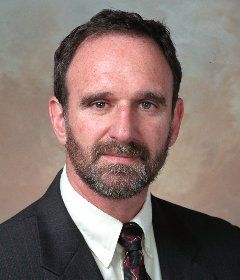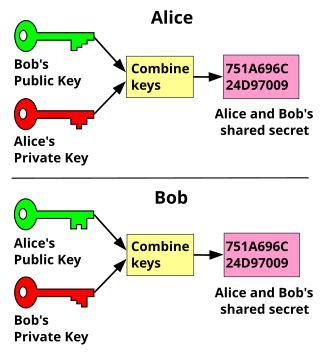
Diffie–Hellman (DH) key exchange is a mathematical method of securely exchanging cryptographic keys over a public channel and was one of the first public-key protocols as conceived by Ralph Merkle and named after Whitfield Diffie and Martin Hellman. DH is one of the earliest practical examples of public key exchange implemented within the field of cryptography. Published in 1976 by Diffie and Hellman, this is the earliest publicly known work that proposed the idea of a private key and a corresponding public key.

Public-key cryptography, or asymmetric cryptography, is the field of cryptographic systems that use pairs of related keys to encrypt and decrypt data. Each key pair consists of a public key and a corresponding private key. Key pairs are generated with cryptographic algorithms based on mathematical problems termed one-way functions. Security of public-key cryptography depends on keeping the private key secret; the public key can be openly distributed without compromising security.
A key in cryptography is a piece of information, usually a string of numbers or letters that are stored in a file, which, when processed through a cryptographic algorithm, can encode or decode cryptographic data. Based on the used method, the key can be different sizes and varieties, but in all cases, the strength of the encryption relies on the security of the key being maintained. A key's security strength is dependent on its algorithm, the size of the key, the generation of the key, and the process of key exchange.
In cryptography, the ElGamal encryption system is an asymmetric key encryption algorithm for public-key cryptography which is based on the Diffie–Hellman key exchange. It was described by Taher Elgamal in 1985. ElGamal encryption is used in the free GNU Privacy Guard software, recent versions of PGP, and other cryptosystems. The Digital Signature Algorithm (DSA) is a variant of the ElGamal signature scheme, which should not be confused with ElGamal encryption.
The Merkle–Hellman knapsack cryptosystem was one of the earliest public key cryptosystems. It was published by Ralph Merkle and Martin Hellman in 1978. A polynomial time attack was published by Adi Shamir in 1984. As a result, the cryptosystem is now considered insecure.
In mathematics, for given real numbers a and b, the logarithm logb a is a number x such that bx = a. Analogously, in any group G, powers bk can be defined for all integers k, and the discrete logarithm logb a is an integer k such that bk = a. In number theory, the more commonly used term is index: we can write x = indra (mod m) (read "the index of a to the base r modulo m") for r x ≡ a (mod m) if r is a primitive root of m and gcd(a,m) = 1.
In the mathematical discipline of general topology, a Polish space is a separable completely metrizable topological space; that is, a space homeomorphic to a complete metric space that has a countable dense subset. Polish spaces are so named because they were first extensively studied by Polish topologists and logicians—Sierpiński, Kuratowski, Tarski and others. However, Polish spaces are mostly studied today because they are the primary setting for descriptive set theory, including the study of Borel equivalence relations. Polish spaces are also a convenient setting for more advanced measure theory, in particular in probability theory.

Martin Edward Hellman is an American cryptologist and mathematician, best known for his invention of public-key cryptography in cooperation with Whitfield Diffie and Ralph Merkle. Hellman is a longtime contributor to the computer privacy debate, and has applied risk analysis to a potential failure of nuclear deterrence.

Bailey Whitfield 'Whit' Diffie ForMemRS is an American cryptographer and mathematician and one of the pioneers of public-key cryptography along with Martin Hellman and Ralph Merkle. Diffie and Hellman's 1976 paper New Directions in Cryptography introduced a radically new method of distributing cryptographic keys, that helped solve key distribution—a fundamental problem in cryptography. Their technique became known as Diffie–Hellman key exchange. The article stimulated the almost immediate public development of a new class of encryption algorithms, the asymmetric key algorithms.

Key exchange is a method in cryptography by which cryptographic keys are exchanged between two parties, allowing use of a cryptographic algorithm.

In 1976 two identical Viking program landers each carried four types of biological experiments to the surface of Mars. The first successful Mars landers, Viking 1 and Viking 2, then carried out experiments to look for biosignatures of microbial life on Mars. The landers each used a robotic arm to pick up and place soil samples into sealed test containers on the craft.
The computational Diffie–Hellman (CDH) assumption is a computational hardness assumption about the Diffie–Hellman problem. The CDH assumption involves the problem of computing the discrete logarithm in cyclic groups. The CDH problem illustrates the attack of an eavesdropper in the Diffie–Hellman key exchange protocol to obtain the exchanged secret key.
SPEKE is a cryptographic method for password-authenticated key agreement.

In cryptography, forward secrecy (FS), also known as perfect forward secrecy (PFS), is a feature of specific key-agreement protocols that gives assurances that session keys will not be compromised even if long-term secrets used in the session key exchange are compromised, limiting damage. For HTTPS, the long-term secret is typically the private key of the server. Forward secrecy protects past sessions against future compromises of keys or passwords. By generating a unique session key for every session a user initiates, the compromise of a single session key will not affect any data other than that exchanged in the specific session protected by that particular key. This by itself is not sufficient for forward secrecy which additionally requires that a long-term secret compromise does not affect the security of past session keys.
In public-key cryptography, the Station-to-Station (STS) protocol is a cryptographic key agreement scheme. The protocol is based on classic Diffie–Hellman, and provides mutual key and entity authentication. Unlike the classic Diffie–Hellman, which is not secure against a man-in-the-middle attack, this protocol assumes that the parties have signature keys, which are used to sign messages, thereby providing security against man-in-the-middle attacks.
The Diffie–Hellman problem (DHP) is a mathematical problem first proposed by Whitfield Diffie and Martin Hellman in the context of cryptography and serves as the theoretical basis of the Diffie–Hellman key exchange and its derivatives. The motivation for this problem is that many security systems use one-way functions: mathematical operations that are fast to compute, but hard to reverse. For example, they enable encrypting a message, but reversing the encryption is difficult. If solving the DHP were easy, these systems would be easily broken.
CEILIDH is a public key cryptosystem based on the discrete logarithm problem in algebraic torus. This idea was first introduced by Alice Silverberg and Karl Rubin in 2003; Silverberg named CEILIDH after her cat. The main advantage of the system is the reduced size of the keys for the same security over basic schemes.
In mathematics, especially in algebraic K-theory, the algebraic K-group of a field is important to compute. For a finite field, the complete calculation was given by Daniel Quillen.
Supersingular isogeny Diffie–Hellman key exchange is an insecure proposal for a post-quantum cryptographic algorithm to establish a secret key between two parties over an untrusted communications channel. It is analogous to the Diffie–Hellman key exchange, but is based on walks in a supersingular isogeny graph and was designed to resist cryptanalytic attack by an adversary in possession of a quantum computer. Before it was broken, SIDH boasted one of the smallest key sizes of all post-quantum key exchanges; with compression, SIDH used 2688-bit public keys at a 128-bit quantum security level. SIDH also distinguishes itself from similar systems such as NTRU and Ring-LWE by supporting perfect forward secrecy, a property that prevents compromised long-term keys from compromising the confidentiality of old communication sessions. These properties seemed to make SIDH a natural candidate to replace Diffie–Hellman (DHE) and elliptic curve Diffie–Hellman (ECDHE), which are widely used in Internet communication. However, SIDH is vulnerable to a devastating key-recovery attack published in July 2022 and is therefore insecure. The attack does not require a quantum computer.
In mathematics, the Bass–Quillen conjecture relates vector bundles over a regular Noetherian ring A and over the polynomial ring . The conjecture is named for Hyman Bass and Daniel Quillen, who formulated the conjecture.






